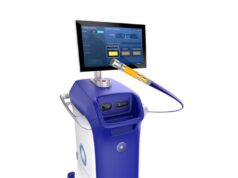
CardioFocus has announced that presentations of the HeartLight system and its role in the treatment of advanced atrial fibrillation were featured at a symposium, titled “Visually guided laser balloon ablation: 1,000 patients ablated in Germany,” on 3 April, in conjunction with the 79th Annual Meeting of the German Cardiac Society in Mannheim, Germany.
The symposium focused on clinical advances with the HeartLight system since its introduction into Germany. It highlighted insights into achieving durable pulmonary vein isolation and optimising long-term procedure efficacy. The programme was chaired by cardiologists Claus Schmitt, Karlsruhe Hospital, Karlsruhe, Germany and Andreas Götte, St. Vincenz Hospital, Paderborn, Germany.
Schmitt commented: “The HeartLight system is fast becoming an established atrial fibrillation treatment option at many centres across Germany and throughout Europe, as physicians continue to document positive patient outcomes and impressive long-term success rates. Our broad experiences in learning and adapting the technology over the past several years provided for rigorous discussion at the symposium. We look forward to continuing to bring forth new insights into the system’s clinical use.”
During the programme, researchers from Asklepios Hospital St Georg in Hamburg, Germany, reported chronic follow-up data using the HeartLight system that demonstrated 75% of patients maintained sinus rhythm post procedure. They noted these findings are comparable to, and may offer improvement over, traditional radiofrequency ablation and cryoballoon ablation systems. Other groups presented on topics including the safety profile of the technology, best practices for achieving complete pulmonary vein isolation, and the potential applicability of HeartLight in addressing persistent atrial fibrillation.
“The studies highlighted at the symposium focused on the versatility of the system, with respect to any patient anatomy, and the promise of laser energy in achieving durable pulmonary vein isolation. Cardiologists in Germany are among those at the forefront of atrial fibrillation ablation research. We are excited by their experiences with HeartLight over the previous 1,000 cases and eager to continue to see the impact of improved clinical outcomes,” said Stephen Sagon, president of CardioFocus.
CardioFocus also announced that this technology has recently been highlighted in two publications in the journals Circulation: Arrhythmia and Electrophysiology and Expert Reviews in Medical Devices. The article in Circulation, authored by Srinivas Dukkipati, Mount Sinai School of Medicine in New York, USA, featured outcomes from the first 200 patients treated with the HeartLight System across 15 different medical centers. In these initial cases, operators were able to achieve 99% acute isolation; the majority of patients remained free from atrial fibrillation and off anti-arrhythmic drugs at 12-months follow-up. Researchers concluded that their findings point to a short learning curve with HeartLight technology. The article was published online on 4 April.
The clinical review article published in the March issue of Expert Reviews in Medical Devices was authored by Stefano Bordignon and colleagues from Cardioangiologisches Centrum Bethanien in Frankfurt, Germany. It discussed the unique design of the catheter ablation system, and noted HeartLight is the first cardiac ablation catheter to incorporate an endoscope for direct visualisation of the beating heart, a laser energy source and a compliant balloon catheter to conform to virtually any pulmonary vein anatomy. The researchers posited that if larger clinical studies continue to substantiate the outcomes achieved to date, then the system would offer a new paradigm in arrhythmia ablation.









